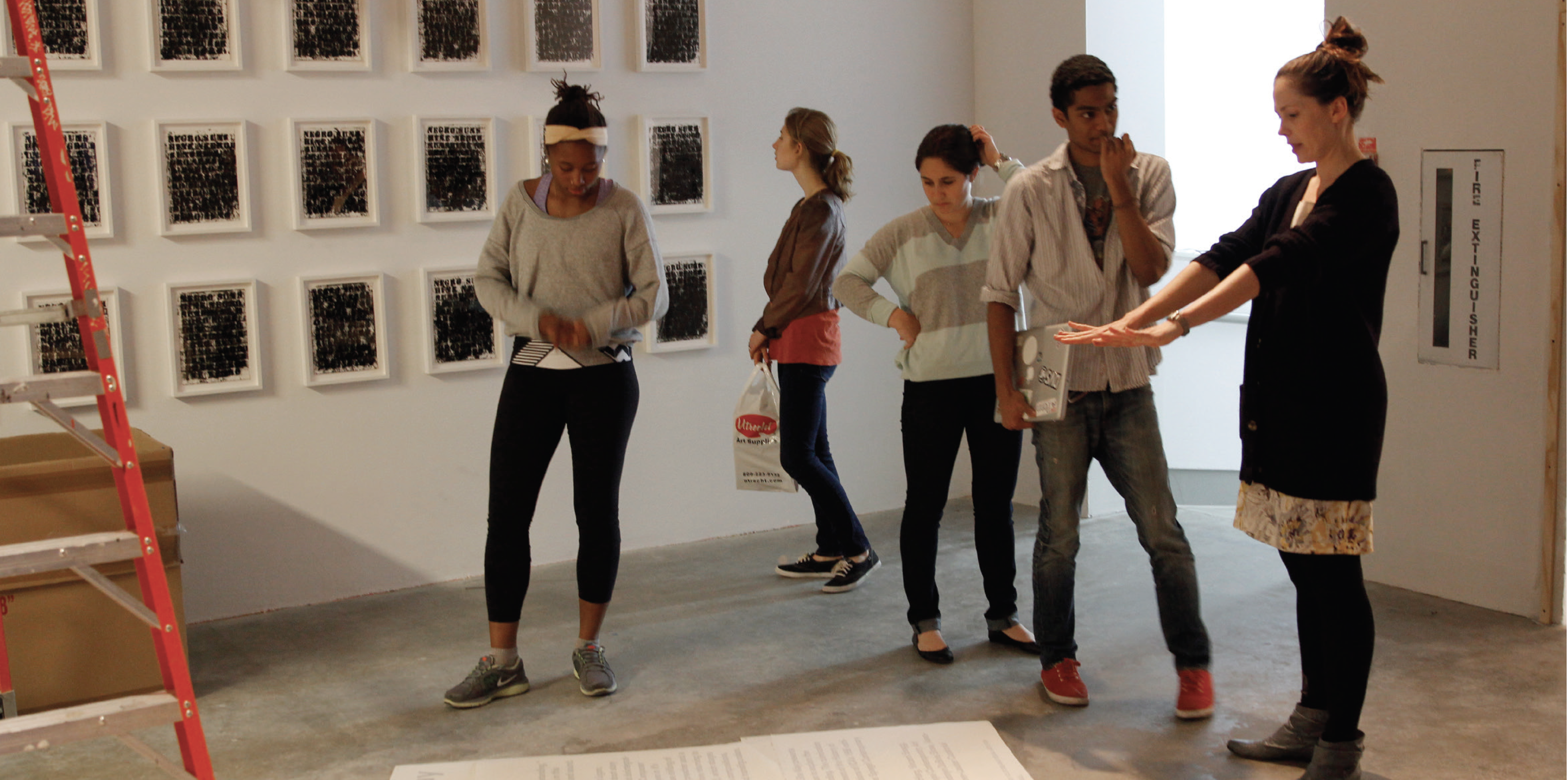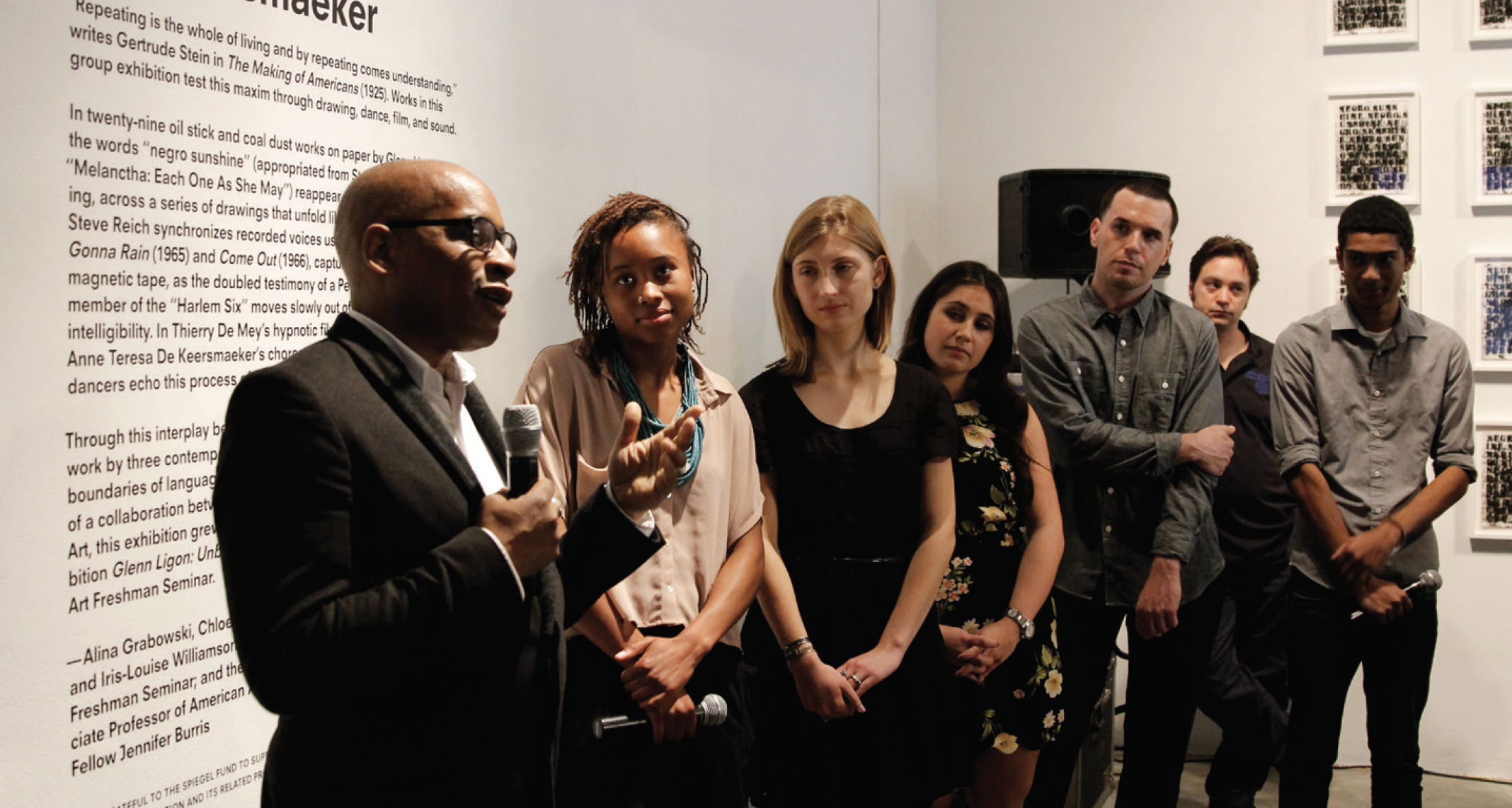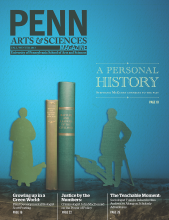Variations on a Theme
Students Become Curators in the Spiegel Contemporary Art Freshman Seminar

In a small, box-shaped room the projection of a solo female dancer flickers on the wall, her movements in sync with the endlessly looping compositions of neo-classical composer Steve Reich. Opposite the dancer, oil-stick paintings treated with black diamond coal dust shimmer in the shifting light. Welcome to the Spiegel Contemporary Art Freshman Seminar’s “Each One As She May: Ligon, Reich, and De Keersmaeker” exhibition, born of five student curators’ creativity and hard work.
The seminar course, offered by the history of art department, began in 2006. It has since resulted in five exhibitions at the Institute of Contemporary Art (ICA). Instructor Gwendolyn DuBois Shaw, Associate Professor of History of Art, and affiliated faculty in Africana Studies, Cinema Studies, and Women and Gender Studies selected the central subject of the current exhibition: Glenn Ligon, who was previously featured in a 1998 ICA exhibit called “Unbecoming.” The students’ first assignment was to immerse themselves in his work, a process that involved researching the archives at Van Pelt Library, multiple trips to New York to examine his works, and eventually a studio visit with the artist himself.
“I worked largely with the ICA archive housed in Penn’s Rare Books and Manuscripts Library,” says Alina Grabowski, C’16. Grabowski, along with classmates Chloe Kaufman, Iris-Louise Williamson, and Vincent Snagg, and Andrew McHarg, LPS’13, comprised the seminar’s roster. “For me, it was a lot of looking at the correspondence between Ligon and the curators at ICA, and seeing through these documents how the ‘Unbecoming’ exhibition came together. Collectively, we spent the first semester really delving into Ligon’s influences and contemporaries. We wanted to be familiar not only with Ligon’s work, but the works that shaped his own art.”
Ligon started as an abstract painter. In the early ’90s, he participated in an exhibition in New York City called “Black Male,” which was curated by Thelma Golden and dedicated to exploring the perception of black men in the media and in the arts. In the years since, he has become an icon of the art scene and was just recently featured in a mid-career retrospective at the Whitney Museum of American Art. His signature works include “text paintings”—displayed prominently in the student exhibit—in which he repeats the same phrase or sentence over and over again, using the same stencil. “He used deeply metaphoric phrases taken from various literary sources like, ‘I’m turning into a specter before your very eyes, and I’m going to haunt you,’ that would start out very clear, but then degrade over time. It was his way of addressing the complex cultural identity of the black male in America,” says Shaw.
The turning point in the class came when they students traveled to Ligon’s personal studio to meet with him face-to-face. Though the students had immersed themselves in studying his career, meeting the actual artist was invaluable in contextualizing his works. “It was a surreal experience,” says student curator Chloe Kaufman. “Not only did we see his studio and chat with him for over three hours, but it was the first time I experienced his work in person. His paintings are very tactile, and although sources that we read in class discussed this distinct element of his work, I did not truly understand his ability as a painter and the dimensionality that his work contained.”
As a kind of icebreaker, the students asked him what kind of music he had been listening to. His answer was Steve Reich, a composer well known for his use of tape loops to create rhythmic patterns of music. When Ligon played Reich’s “Come Out” for the students, they were able to connect the visual, physical aspect of the repeating words in Ligon’s work to the aural looping component of Reich.
But something was still missing. For the exhibition’s theme the students had settled on repetition, or “phasing” as they referred to it, but it needed something kinetic to bring it to life. That’s where dancer Anne Teresa De Keersmaeker came in, a choreographer who had tailored her performances to Reich in the past. “De Keersmaeker’s company, Rosas, was willing to let us use video of the dances, but they had a few requests—namely a projector capable of 9 million lumens, and that the performance was shown from up above on a bed of sand,” Shaw laughs. “We said, ‘That would be great, but it’s not feasible.’ But in the end it worked out and everything looks fantastic.”
The students were involved in every aspect of the exhibition, which drew its name from Gertrude Stein’s “Melanctha: Each One as She May,” a story Ligon cited as an inspiration for its examination of race, sex, and gender through a repetitive narrative structure. “The guidelines for constructing the exhibition were very open-ended, and because the course was so unique, there was no precedent to look to for ideas,” says Kaufman. “We developed a wide range of concepts for the exhibition and spent a lot of time fleshing them out before making a final decision.”
In addition to the physical construction, the students handled everything from advertising to press releases and posters. They harnessed social media using Facebook and Wordpress, and a Tumblr blog for updates. And as a final touch, each student curator authored an essay for the exhibition catalogue. “We each picked something that we felt had really impacted us during the curatorial process,” says Grabowski. “They were more about how we connected to the exhibition, rather than trying to analyze our influences. It allowed me to think about how working on it had come to mean something to me not only intellectually, but personally.”
The most rewarding moment though, Shaw says, was when Ligon personally attended the opening. “He really opened up to these students. And for him to come and speak in this space they had created with all their hard work—it was great to see.”





